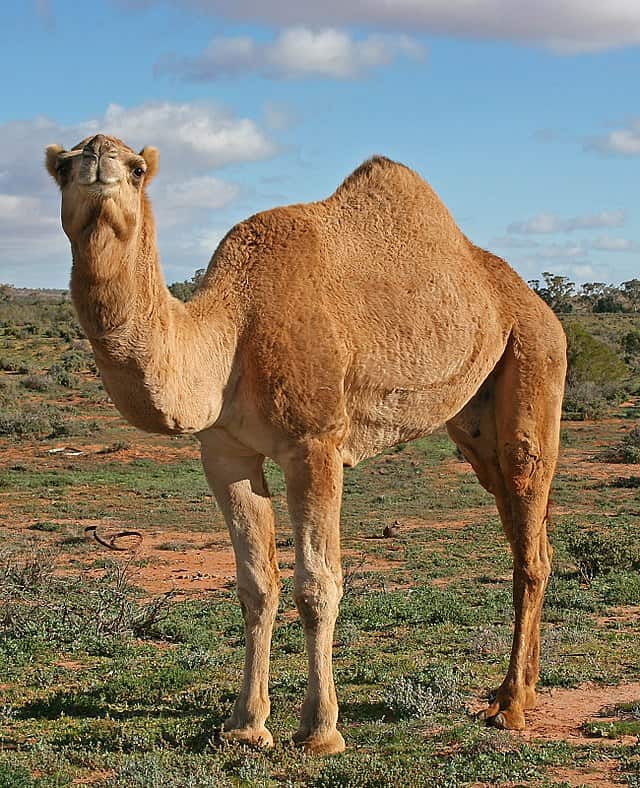Did you know that the horn of rhinoceroses is made of the same protein, keratin, as their hooves? Or that the domestic sheep has a population of over 1 billion globally? From the vast grasslands of Africa to the rocky terrains of Asia, hoofed animals, scientifically known as ungulates, have imprinted their mark quite literally on the earth beneath them. It’s estimated that there are over 200 species of hoofed mammals spanning across all continents except Antarctica. Though seemingly simple structures, their hooves play a critical role in their survival, aiding in everything from speedy escapes from predators to digging for water in arid landscapes.
Let’s dive deep and learn more about these amazing hoofed animals and why they have their super-important hooves.
1. Zebra (Equus zebra)
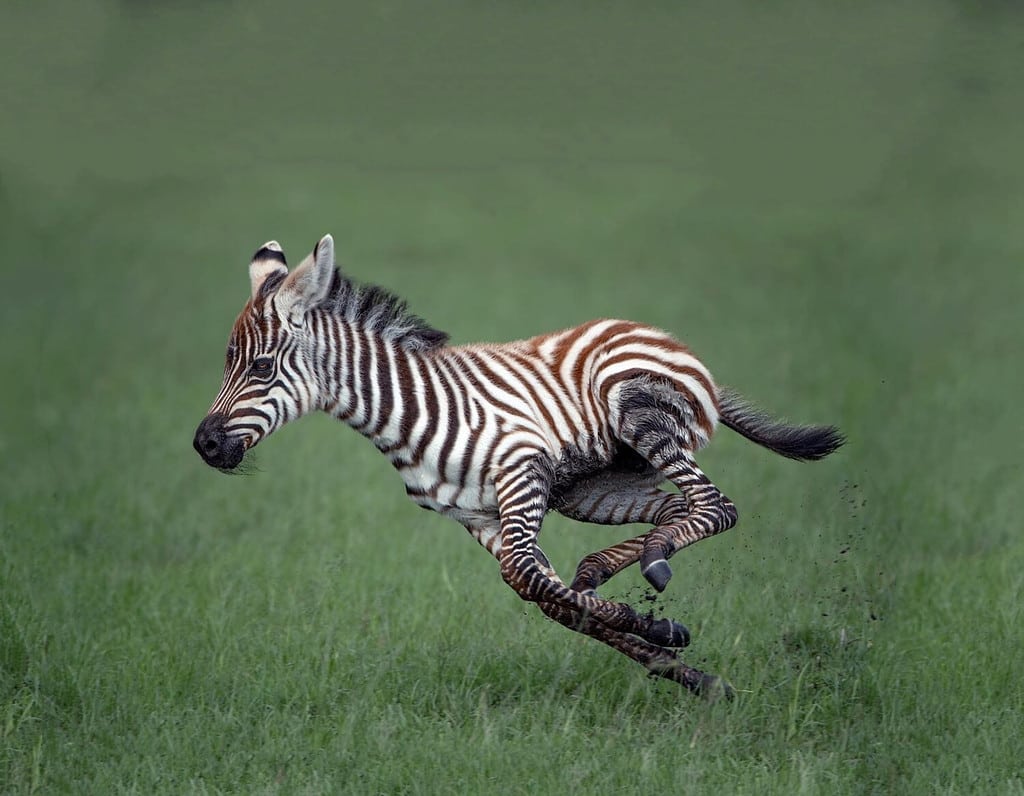
With strong hooves, Zebras are fast and agile creatures. Their hooves help them run more than 40 miles per hour!
©Vladimir Turkenich/Shutterstock.com
Zebra, with their iconic black and white patterns, are medium-sized herbivores native to Africa. These striking animals weigh about 450 to 950 pounds, and they gracefully stand roughly 3.5 to 5 feet tall at their shoulders. They are part of the equine family, which also includes horses and donkeys. Zebra are herbivores that primarily feed on grass, shrubs, and leaves. They live in large groups, sticking together for safety, especially from predators like lions, hyenas, cheetahs, and wild dogs.
Fun fact: The stripes on zebra help them control their temperature. The black stripes absorb heat during cool mornings and the white stripes reflect heat in the warm afternoons.
Why Do Zebras Have Hooves?
Zebras hooves are tough and sharp, perfectly suited for rocky and steep paths. The regions that zebra live in have two distinct seasons: wet and dry. Water is very scarce in the dry season. Amazingly, some zebras can even use these specialized hooves to dig up water in dry places. And when danger approaches, those strong hooves help them dash away swiftly. All of these traits show the beauty and adaptability of nature.
2. Deer (Cervidae)
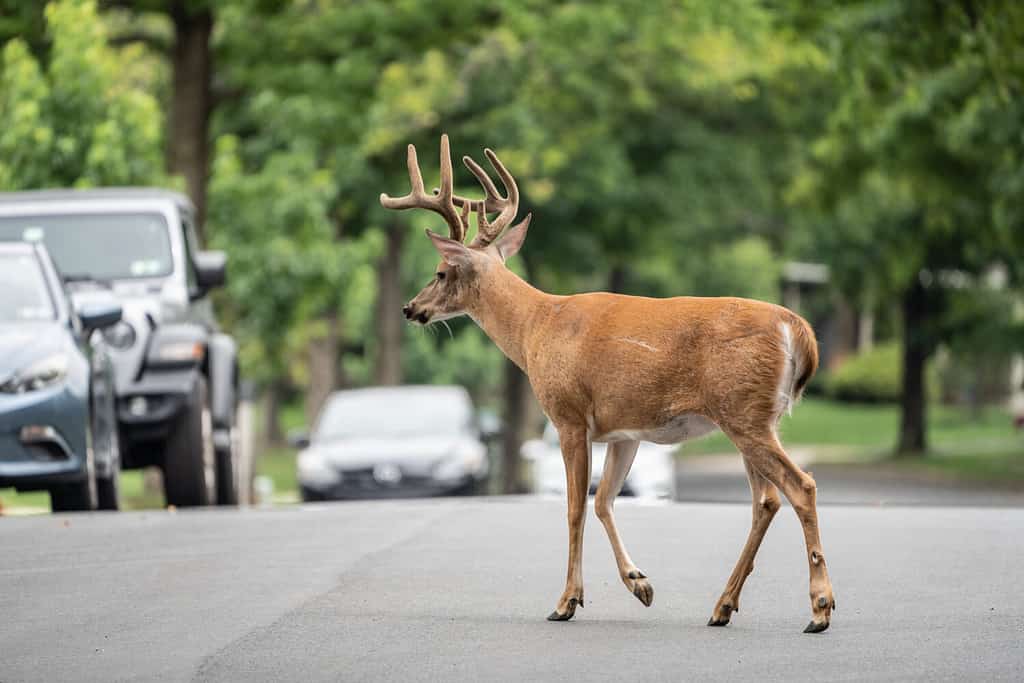
Deer are common hoofed wild animals. They can thrive in many different biomes and climates.
©Amy Lutz/Shutterstock.com
There are millions of deer around the world, separated into more than 40 unique species. Whitetail deer, the most common species, stand between 3 to 3.5 feet tall at the shoulder. And weigh around 130 to 300 pounds. Deer are herbivores that eat a variety of different vegetation, such as grass, leaves, and sometimes twigs. Intriguingly, deers are most lively at dawn and dusk, which means they’re crepuscular. They’ve made homes in various places, from dense forests to open grasslands. Male deer can be identified by their large antlers, which they shed and regrow each year!
Why Do Deer Have Hooves?
Deer hooves are so much more than feet; they’re survival tools. Hooves help deers move swiftly, either when they’re running away from predators or searching for a tasty snack. Solid and rugged, their hooves hold their weight and shield them from sharp, rocky terrain. What’s truly amazing is the cloven design of their hooves, which gives them a better grip, especially on tricky surfaces. Nature indeed designed deer hooves thoughtfully for life in the wild.
3. Cow (Bos taurus)
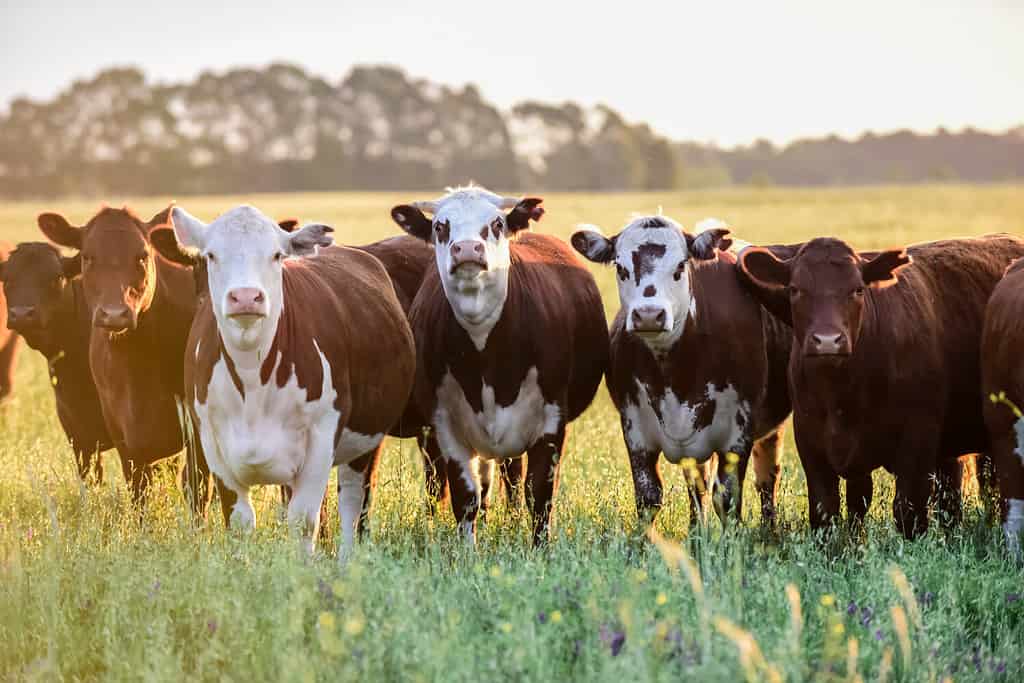
There are more than 1 billion cows in the world, in almost every country and continent besides Antarctica.
©Foto 4440/Shutterstock.com
Cows are one of the most numerous species on the planet, with more than 1 billion worldwide. In fact, there are over 1,000 distinct cattle breeds! Standing impressively between 4.5 to 5.5 feet at the shoulder, cows have a strong build and can weigh anywhere from 1,000 to 2,400 pounds. Cows have cloven hooves and black, pure white, or even rich brown coats. What do they eat? Mostly grass, but they also enjoy hay and silage. These gentle giants are surprisingly social. Usually, they hang out in groups, or as we call them, herds. This social nature and their preference for grazing together highlight just how important they’ve become in farms all around the world.
Why Do Cows Have Hooves?
Cows have strong, tough hooves to support their big bodies. As they roam and graze, their hooves protect them from sharp or uneven ground. Plus, the split design of their hooves, which looks a bit like two toes, provides a better grip, especially on wet or muddy surfaces. It’s not just about looks; it’s about function. Hooves are essential for cows, whether in wild grasslands or on a bustling farm.
4. Horse (Equus ferus caballus)

Horses are beloved hoofed animals that humans originally domesticated around 6,000 years ago.
©Madelein Wolfaardt/Shutterstock.com
There are an estimated 400 horse breeds with more than 60 million individuals. Horses stand impressively from 3 to 6 feet at the shoulder and typically weigh about 900 to 1,200 pounds. With a wide variety of majestic coats, horses can be as dark as night or white as snow and pretty much everything in between. They mainly munch on grass, hay, and grains but also enjoy the occasional apple or carrot. Horses are super social and prefer being in groups. Always active during the daytime, they are generally very docile and friendly animals. Horses are known for their speed and endurance, with some breeds able to run up to 40 miles per hour.
Why Do Horses Have Hooves?
Horses have solid hooves that are designed to protect their feet. Since they essentially spend their lives on their feet, horse hooves are extremely important. They support their heavy weight and allow them to sprint without slipping. Additionally, their hooves allow them to run faster for longer distances. These hooves are made of tough keratin on the outside, with bones, tendons, and ligaments on the inside.
5. Hippopotamus (Hippopotamus amphibius)

Hippos are extremely aggressive and dangerous animals. If you see one in the wild, keep your distance!
©Otto Borik/Shutterstock.com
One of the most dangerous animals in the world is the hippopotamus. Growing to around 5 feet tall and weighing between 3,000 and 9,000 pounds, hippos are massive, to say the least. They have distinctive large heads and torsos with short, stubby legs. The skin of hippos is smooth, with barely any hair. Interestingly, hippos produce their own sunscreen through their sweat. They secrete a thick, mucus-like sweat that, when dried, protects the animal from the harsh UV rays of sub-Saharan Africa.
Hippos can hold their breath for around 5 minutes and spend lots of time in the water. They are also extremely aggressive, killing more than 500 people per year!
Why Do Hippos Have Hooves?
Hippos have very unique hooves. Instead of a single or double hoof, hippos have hooves on each of their toes. Also, because they tend to spend time in the water, their feet are webbed. Hippo hooves are very different from most of the other hoofed animals on this list, acting more like extra-strong toenails than traditional hoofs.
6. Goat (Capra aegagrus hircus)
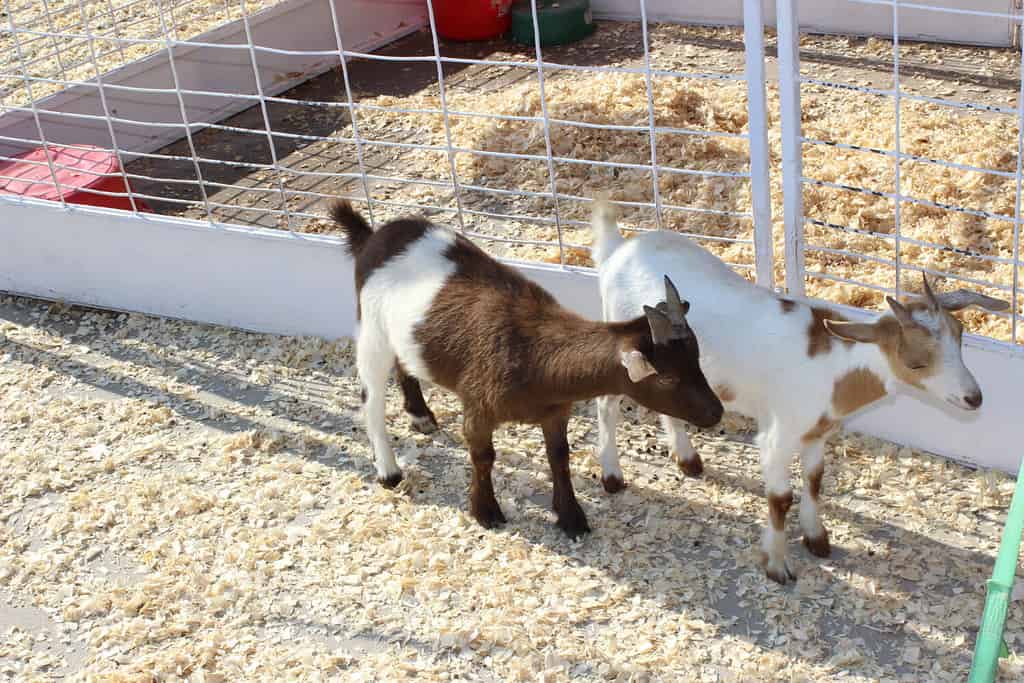
The hooves of goats allow them to climb up tough, rocky terrain.
©Jon Kraft/Shutterstock.com
Goats are domesticated hoofed animals that stand roughly between 2.5 to 3.5 feet tall and tip the scales from 100 to 310 pounds. Goats can be easily identified by their beard and horns. Thought to be one of the first animals to be domesticated by humans, goats have been bred for around 9,000 years! Their incredible skill to live and adapt to just about any climate and terrain from cold mountain ranges to rocky cliffs and hot deserts.
Fun fact: Goats are not thought to be the most intelligent animals, but they can even learn their names and come when called!
Why Do Goats Have Hooves?
Goats have hard, sturdy hooves, and there’s a reason. They’ve evolved to tackle rough, bumpy lands often found in wild areas. These strong, hard hooves give them an excellent grip, especially when darting up steep paths. Their split-hoof design also helps them stay balanced, which is super important when being chased by predators. As natural armor, these hooves shield their feet from nasty cuts. Some mountain goat species can even climb up extremely steep, almost vertical inclines with their hooves.
7. Antelope (Bovidae)
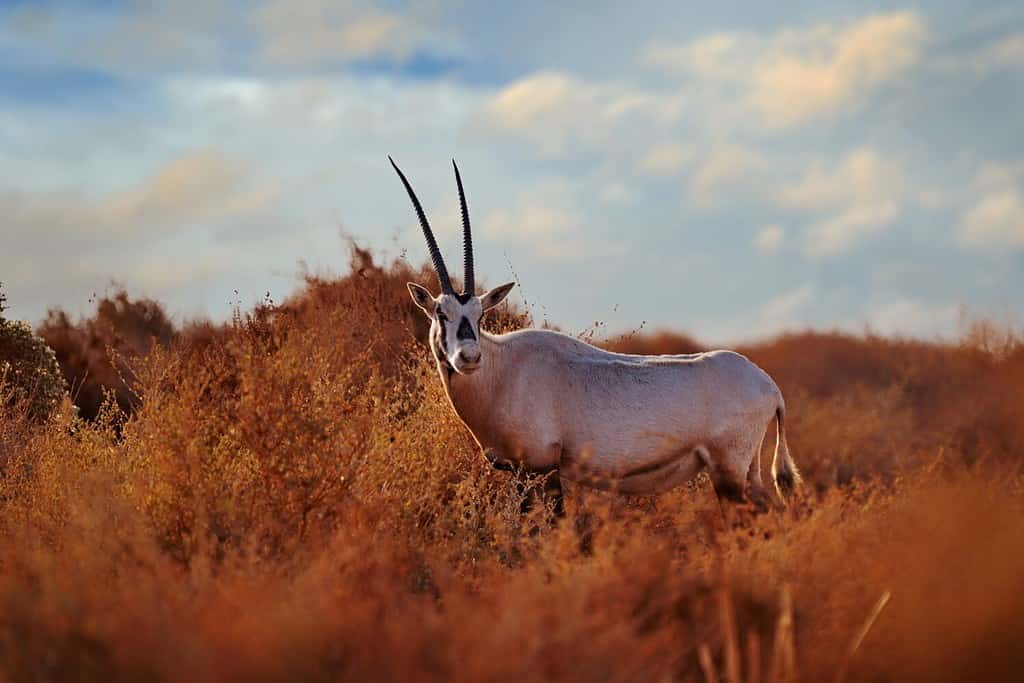
The Arabian oryx is a type of antelope native to the Arabian Peninsula.
©Ondrej Prosicky/Shutterstock.com
The antelope is not a single species but rather a blanket term for more than 90 different species spread across Africa and Asia. They range in size from a modest 2 feet to a towering 5 feet and weigh anywhere from 20 to a hefty 2,000 pounds. Many antelope species have long, twisty, or bendy horns. They are herbivores, primarily eating grass, leaves, and other herbs. Antelopes are social creatures, roaming in herds that keep them safe from predators. Their coats are generally brown or grey, which gives them an all-natural disguise. Antelopes are known for their speed and stamina, especially when dodging threats.
Fun fact: The goitered gazelle is the fastest species antelope species and can run up to 60 miles per hour!
Why Do Antelopes Have Hooves?
Antelopes have strong hooves that help them run fast. These hooves are perfectly designed for the grasslands and wide-open savannas they call home. Antelopes can run around super-fast with these hooves, which is handy when avoiding danger. Additionally, antelope hooves are split in the middle, offering good grip and ensuring they stay steady during speedy getaways.
8. Sheep (Ovis aries)
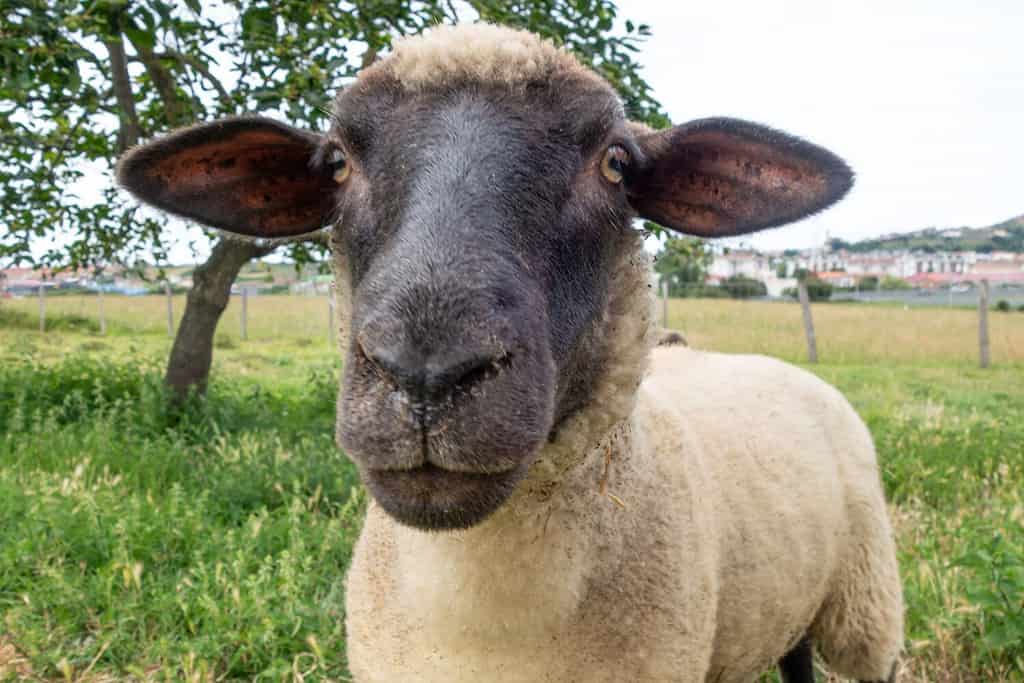
Sheep are one of the most numerous hoofed animals in the world, with nearly 1.3 billion.
©ENRIQUE ALAEZ PEREZ/Shutterstock.com
Did you know there are more than 25 million sheep in New Zealand? That is more than 5 sheep per person! Sheep are medium-sized domestic animals, standing 2 to 3 feet tall and weighing 100 to 300 pounds. They are farmed for their wool, which is used to produce clothing and textiles.
These animals spend most of the day grazing, consuming around 3% of their body weight in grass each day.
Why Do Sheep Have Hooves?
Sheep sport split, sturdy hooves on each foot. Evolutionarily, these hooves act like shoes, protecting their feet from the tough ground. They’re hard and keep the sheep safe from sharp objects. Moreover, the split in the middle helps them grip the ground better, especially on slippery grounds. So whether they’re walking, running, climbing hills, or munching on some grass, their hooves help them do it safely.
9. Camel (Camelus)
Camels are a common domestic animal in the Middle East and Northern Africa. They are tall creatures, around 6 to 7 feet at the shoulder height, weighing 880 to 1,325 pounds. Also, camels have one or two distinctive humps on their back. These humps store fat which helps them survive in super-hot deserts. As herbivores, camels munch on essentially any plant they find, even dry grasses and grains. They are highly adapted to desert environments and have been an important form of transportation in the Sahara desert and Arabian Peninsula for thousands of years. Amazingly, they can go on for days without water or food, proving their incredible stamina. With those long legs and big feet, deserts are their playground. Hence, many affectionately call them the “desert ships.” Interestingly, the largest camel population is in Australia, where they were not introduced until the 184os.
Why Do Camels Have Hooves?
Camels have broad, strong hooves that work like built-in desert shoes. These hooves spread their weight on the sand so they don’t sink. Plus, the bottom part is like a cushion, guarding their feet from the burning desert ground. These hooves are they’re crucial for long, arduous desert journeys. So, when you think of camels, remember that both their hooves and their humps are their superpowers, helping them thrive in the sandy stretches.
10. Water Buffalo (Bubalus bubalis)
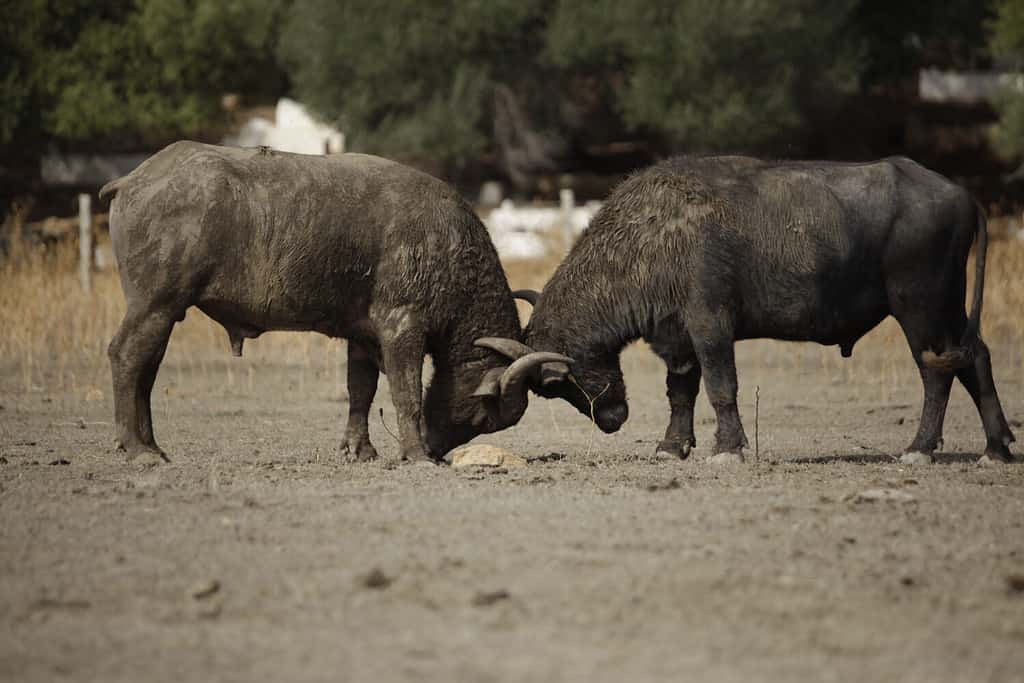
With huge horns and massive bodies,
water buffalo
are a huge domestic hoofed animal.
©Agarianna76/Shutterstock.com
Water Buffalo are massive domestic creatures standing 5 to 6.6 feet tall at the shoulder and weighing a hefty 700 to 2,200 pounds. They are primarily found in South and Southeast Asia, but some are now in Australia, Europe, Africa, and the Americas. Water Buffalo are covered in thick, dark skin and sport massive, extended horns. Despite their massive size, they are gentle and are relatively easy to tame. Water buffalo are important animals in agriculture, used for plowing fields and transporting goods in rural communities.
Why Do Buffalo Have Hooves?
Buffalo need sturdy feet to support their big bodies. These wide, tough hooves act like all-terrain shoes, helping them walk smoothly in muddy or rocky places. They also protect their feet from anything sharp on the ground. Water buffalo hooves give them a firm grip and keep their feet safe. Whether they’re just grazing or wading through muddy bodies of water, these hooves allow buffalo to move steadily and confidently.
11. Donkey (Equus asinus)

While they look very similar to horses, donkeys have slightly different features.
©BalkansCat/iStock via Getty Images
Donkeys are another hoofed equine animal closely related to horses. Slightly smaller than horses, donkeys are sturdy animals, standing between 3 to 5.5 feet tall at the shoulder and weighing roughly 400 to 570 pounds. They are typically covered in a fuzzy gray or brown coat. These herbivores love eating grass, shrubs, and grains. Donkeys are incredibly tough and have a ton of stamina. This is why many people use them as work animals, especially for carrying goods. You can tell them apart from horses due to their long ears, short tails, and smaller size.
Why Do Donkeys Have Hooves?
Donkeys have hooves, and there’s a good reason for that. These hooves are tougher and stand up straighter than horse hooves, which are perfect for walking on rocky, dry lands. They give a firm grip and shield their feet from the rough ground. And the best part? Their hooves require less care than horses. While you will still definitely need to trim their hooves, you’ll do it less often than horses.
12. Rhinoceros (Rhinocerotidae)

The skin of a rhino is so strong and thick that it can resist low-caliber bullets.
©Jurgens Potgieter/Shutterstock.com
Rhinoceroses are real life unicorns! Massive creatures with horns in the center of their large heads, rhinos are truly majestic. With a body covered in thick, shield-like skin, these giants are herbivores that eat leaves, shoots, and twigs. Interestingly, rhinos are pretty solitary animals; they often hang out alone or in small groups. Rhinos have been hunted for years, and illegal poaching has almost wiped out their population. Sadly, they’re a critically endangered species, and without intensive conservation efforts, they could be extinct in the next few decades.
Why Do Rhinoceroses Have Hooves?
Rhinos, like hippos, have strange hooves that are unlike most other hooved animals. They have three large toes that are each encased in a tough hoof. These tough, keratin-made hooves are extremely practical, supporting their heavy bodies. The three-toe design helps distribute their immense weight, ensuring they stay balanced. Whether they’re munching on grass, quickly moving away from danger, or guarding their space, these hooves are essential for rhinos. They’re like the sturdy shoes rhinos always wear for their rough-and-tough lifestyle.
13. Giraffe (Giraffa camelopardalis)
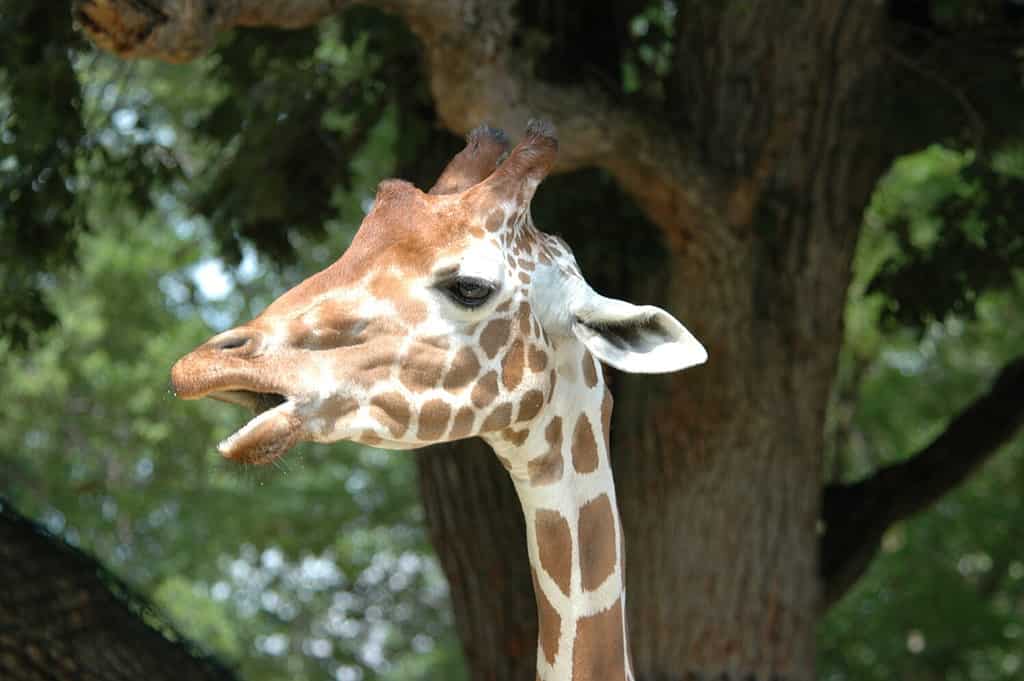
A kick from a giraffe can decapitate and kill a
lion
!
©Bull's-Eye Visual Arts/Shutterstock.com
An evolutionary wonder, giraffes are the world’s tallest mammal. They grow to a towering height of up to 18 feet and can weigh a whopping 1,800 to 3,000 pounds. These majestic creatures have incredibly long necks and legs, which allow them to reach the leaves of tall trees. They mainly eat acacia leaves, flowers, and fruits. Despite their huge size, giraffes are quite chill and are found hanging out in small groups. They stay in these groups to avoid predation, as they are too large to hide from lions and crocodiles.
Fun fact: The spotted design on each giraffe is unique, kind of like a personalized outfit.
Why Do Giraffes Have Hooves?
Giraffes have special hooves built to handle Africa’s rugged grounds. These split hooves give them a stable foundation, balancing their tall frames. The tough exterior of their hooves guards them from sharp rocks and prickly thorns. And you wouldn’t want to mess with a giraffe; those hooves pack a powerful punch when they kick. A single kick from a giraffe can kill and even decapitate a fully grown lion. So, giraffe hooves double as a lethal weapon!
Summary of the Types of Hoofed Animals (And Why They Have Them)
| Number | Animal | Scientific Name |
|---|---|---|
| 1. | Zebra | Equus zebra |
| 2. | Deer | Cervidae |
| 3. | Cow | Bos taurus |
| 4. | Horse | Equus ferus caballus |
| 5. | Hippo | Hippopotamus amphibius |
| 6. | Goat | Capra aegagrus hircus |
| 7. | Antelope | Bovidae |
| 8. | Sheep | Ovis aries |
| 9. | Camel | Camelus |
| 10. | Buffalo | Bubalus bubalis |
| 11. | Donkey | Equus asinus |
| 12. | Rhinoceros | Rhinocerotidae |
| 13. | Giraffe | Giraffa camelopardalis |
The photo featured at the top of this post is © Amy Lutz/Shutterstock.com
Thank you for reading! Have some feedback for us? Contact the AZ Animals editorial team.




